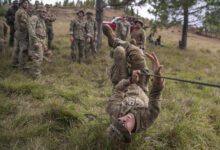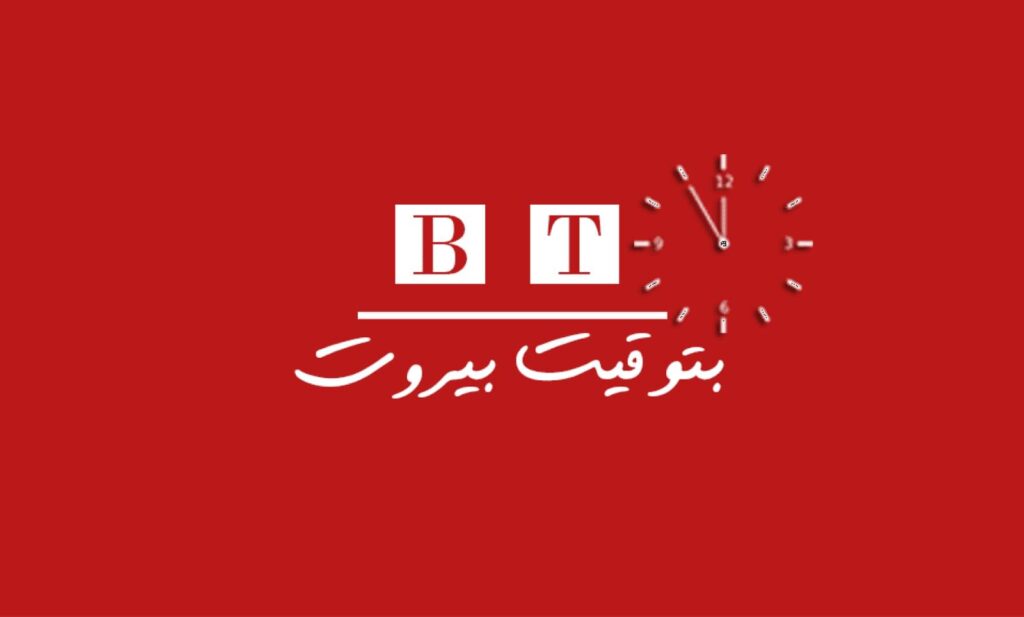اخبار مترجمة :How the Swedish Air Force is finding its flow as part of NATO
The commander of the Swedish Air Force, Maj. Gen. Jonas Wikman, has led the flying force since December 2022, overseeing the integration efforts of Sweden into NATO’s deterrence and defense posture since joining the alliance in March. He spearheads a force of 2,700 military personnel and fighter fleet numbering almost 100 aircraft. Sweden has proposed to increase its defense spending to 2.6% relative to the size of its economy by 2030.
In an interview ahead of the Farnborough Airshow in the United Kingdom, which runs July 22-26, the air chief touched on the dogged obstacles of information-sharing among allies, the lessons from the air war in Ukraine, and how air forces must be prepared to fight in more contested electronic warfare environments in the future.
This interview was edited for length and clarity.
What are some of your observations from the air war in Ukraine, and what lessons should the training of the Swedish air force personnel entail as a result?
First of all, speaking from a national perspective, there’s a lot of experiences that have confirmed our earlier beliefs. One of them is the control of the air, where the necessity of controlling the airspace is quite obvious if you want to control your territory. If Ukraine had been able to control the air over Kyiv in the first few days of the full-scale invasion, we would have potentially seen a whole different kind of outcome.
The war makes it evident and reminds us as commanders that we need to convey to a larger audience the necessity to be prepared from day one to control our airspace and of having Day Zero capability as well as air defense. An example of this is the Nordic cooperation, where one of the foundations is the need to operate together in peace time and have the capability in place.
RELATED
:quality(70)/cloudfront-us-east-1.images.arcpublishing.com/archetype/OG7WWX7I7RDHJCKCDPI7KUKROI.jpg)
Connected to that, the effect of having a strong and integrated air defense, as well as the potential we hold in combining our ground-based and air-based air defense – that has become a higher priority for all of us since looking at Ukraine.
With air defense being arguably more important than ever, what does that focus look like for you?
We already have our ground-based air defense, which belongs to the Swedish Army in peacetime and to the Air Force in wartime. We have bought Patriot systems and are looking forward to procuring more systems capable of defending at the brigade and wing level since we have medium-range air defense weapons but need more short-range ones.
Sometimes when we talk about air defense and integrated air and missile defense, we talk about defending assets, aircraft, and other ground-based systems. However, the overall concept is also important – for Sweden, which comes from a history of total defense, we normally look at defense capabilities on a wider scale.
In my perspective, integrated air and missile defense includes everything from export control to the “left-of-launch” all the way through the military part of it – which is ground- and air-based air defense but also our nation’s capability to withstand an attack. There also needs to be a whole-government approach to air defense that we need to adopt as well.
Based on what we are seeing unfold in Ukraine, where drones have taken on a huge role, what changes or modifications around unmanned systems is the Swedish Air Force making when it comes to training and new acquisitions?
We have made adjustments to our plans. We are procuring more counter-UAS systems to protect our bases and airspace, we are also trialing within all the branches of our armed forces how we can be more effective using drones ourselves.
We are also buying a brigade-level unmanned aerial vehicle, but have not yet decided to procure more strategic ones like the MQ-9 Reaper mostly because it does not fit our size or budget. However, we are looking into cooperation within Europe, NATO, and the Nordics to be able to have access to that kind of capability all the time.
Overall, we try to follow everything happening in Ukraine where the development speed is mind-blowing. Everybody is attempting to draw conclusions about where the war is heading, while also trying to be careful not to conclude where it’s going.
For us, one obvious area is the capability to counter different kinds of UAS, including one-way attack drones or whichever other system it might be with electronic warfare or early warning systems.
So far, our focus has been more on countering than attacking with drones. We are all trying to figure this out but for the moment, with our current plans that’s the focal point – but like everybody else we are also trialing unmanned and artificial intelligence assets.
Many countries are considering a loyal wingman drone or remote carriers to accompany their next-gen fighter. What is your view on the utility of those concepts and how could current technology residing in Swedish companies (autonomy, AI, etc.) support it?
I get this question a lot and I always have to say the same thing. We are still early in our process so I try to be careful not to decide or set my mind on which road to go down. Of course, I also see future systems being AI-supported and some combination of manned-unmanned, to me that’s quite clear.
When we look at future fighting systems or a next-generation fighter, we are focusing a lot on the platform of one or two, or the combination of two platforms. For Sweden, going back to our history, as a small air force under perceived big threats, we have had to combine different kinds of capabilities into one system.
Currently, we are using low-personnel usage, dispersed operations as a concept and are looking into what would be our future concept. To us, it is very much about the use of systems of systems, and in that, it is obvious that we will have an unmanned-manned system.
Whether that is a typical loyal wingman or another asset, I don’t know yet.
In the area of air combat and air defense, how can Europeans cooperate more effectively to strengthen their defensive posture?
Overall, what I see right now in all my contacts with the European and NATO air chiefs is a whole different mindset regarding cooperation than before. Historically, some of the problems we have had were related to never being on the right timeline or never having the right economy for more cooperation projects. It is also important to note that every nation has its own kind of goals and targets, which has made the setting up of a greater number of common initiatives challenging.
Now, it is the effect of the common view of the security situation in Europe and the sense of urgency that really affects how we view cooperation for the future. I see very clearly in my conversations that cooperation we didn’t have before or didn’t want previously because it was perceived as ineffective in building our own air forces, now all of a sudden, it is necessary since we share the same goal.
For us, to cooperate more effectively requires overcoming some of the existing obstacles – an obvious one being information sharing, but we are trying to address that when it comes to operational coordination between our capabilities and those of other nations. Everything from intellectual property to national security threats – the area of information sharing is one where we really have to make some changes.
Is there the same sense of urgency felt all across Europe or is it your view that some nations might still not feel an acute need to strengthen their own and collaborative defensive posture?
Certainly, there are differences amongst nations that stem from having a different sense of urgency, sometimes connected to the distance a country has between itself and the threat. However, everyone agrees on the overall problem of needing to cooperate more effectively and address information-sharing issues – it is very high on the agenda.
For instance, for NATO Allied Air Command, one of the main priorities is enhancing information sharing, both now with current capabilities and for future cooperation.
However, we are all struggling, all of us, as there are many built-in obstacles within the industry, nations, and different armed forces that exist to protect each of their functions but make this complex. I choose to stay positive since we are only a few years into this kind of newer situation where this is needed and have realized what we need to do
In your opinion, when looking at the barriers that make sharing data difficult, does one of them stem from a level of distrust, even amongst allies, or simply put there is always a general sense of uneasiness in disclosing sensitive information?
I see what you mean. One part is to, of course, build trust, but I don’t think that this is the main obstacle right now. We have built information systems as well as security protocols and regulations that were set up to protect all information, rather than being set up to share it as effectively as possible.
It has a lot to do with turning these processes around and setting the right goal – before it was to make sure no data was supposed to be somewhere else. Now, the aim for all of us is operational capabilities and that means we need to fundamentally change the way we process information.
A lot of it is bureaucracy in its best form, and I understand that we come from a different history and have established information laws with distinct setups for a reason. For us, as a new NATO member, it is very obvious that to figure out how to match our piece of the puzzle in the bigger context and have information about capabilities and systems, new ways of sharing data are necessary.
I am not a lawyer here, but it is quite obvious to us since joining NATO that we need to change a lot of the regulations and laws to be able to share information and operate together, train together, and that on different territories.
One part is to have the right rules in place, and the other is to delegate mandate and have the kind of processes in place to share or change information on the level where actual capabilities can be combined.
How is the Swedish air force personnel preparing for operating in GPS-denied or jammed environments, a problem that has become acute in Ukraine?
When it comes to GPS navigation systems, that is not a particular problem for us — we have our systems set up to be able to operate without them. It is of course a problem for the security of the nation, which we need to encounter. But when it comes to our operations within the Air Force, we are quite familiar and prepared for it.
I would rather focus on the electronic-warfare aspect on a wider scale. We are preparing for a future conflict where the electronic spectrum will be much more contested. That’s one of the main reasons we have these future capabilities on the Gripen-E fighter, which has a high electronic warfare capability as we believe that it will only have to work in a more contested and tougher environment in the future.
We need to refocus on this and have started to do so. Back in the day, we as a nation used to be good at fighting in an environment where radio traffic was jammed. Then, for a few years we lost a little bit of our culture when it came to our position and mindset on electronic warfare.
So now, we are reevaluating whether or not we need more education on every level when it comes to electronic warfare to be able to fight in future settings. That’s really important to us to account for this and there is room for progress in this respect for us and many others, I think.
What would progress look like for you to address this? For instance, would it entail dedicating a whole unit to electronic warfare specifically or would you rather see it implemented at every level into military training?
The tip of the spear is always constructed by the organization behind it. So if we want to be really good at this in the future, including in the procurement of equipment, we need to build a base for that and that starts with knowledge on all levels — this is the aspect I am talking about, including basic-know how of electronic warfare for every Swedish airmen.
Other than that, different units — maybe. I think the greatest potential, to go back to your question about enhancing European defense cooperation, would be to look at how we best combine assets.
For instance, how do we form the Gripen-E and our capabilities on other platforms to fit in a wider context? How do we combine the Gripen-E with the F-35 when it comes to electronic warfare and how does that look in the future?
Some bigger nations would possibly be able to procure special assets or have special electronic warfare units, which we could merge with our efforts. Electronic warfare today is a common challenge that should be addressed and rooted in cooperation.
What patterns have you observed lately when it comes to Russian military aircraft near Scandinavian airspace?
The overall situation and the fact that we have a war in Europe certainly affects our area of operations when it comes to the Baltic Sea and our territory — everything is connected. We see the same kind of atmosphere going on in different areas over the Black Sea and the Baltic Sea.
So there are a lot more assets in our vicinity — that is NATO assets, our national assets, but also Russian assets. The level of activity is definitely higher than it used to be, and of course, the overall atmosphere has also translated into our airspace.
Our readiness when it comes to defending our territory is on a higher level than it used to be, and we do more QRA (quick reaction alert) sorties than we used to do. The intensity is higher and that means we need to also be ready to observe, collect information, and defend our territory and NATO’s.
We have instances where Russian aircraft are very close to our territory, even violating it like it happened a few weeks ago but I don’t want to exaggerate the situation either.
The word I would use to describe the general mood is high-intensity, where activity is higher, there are a lot of aircraft, a lot of capabilities, everybody is increasing their capability and the overall atmosphere is thus affected. In terms of Russian activity, we do observe that there is jamming going on, but we don’t see any attacks towards us.
Elisabeth Gosselin-Malo is a Europe correspondent for Defense News. She covers a wide range of topics related to military procurement and international security, and specializes in reporting on the aviation sector. She is based in Milan, Italy.
JOIN US AND FOLO
Telegram
Whatsapp channel
Nabd
GOOGLE NEWS
tiktok
مصدر الخبر
نشر الخبر اول مرة على موقع :www.defensenews.com بتاريخ:2024-07-17 19:37:32
ادارة الموقع لا تتبنى وجهة نظر الكاتب او الخبر المنشور بل يقع على عاتق الناشر الاصلي
تم نشر الخبر مترجم عبر خدمة غوغل






